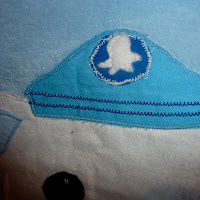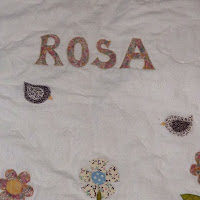So we have here the Octonauts blanket. Designed for my son's friend's 5th birthday, and now in the process of being replicated for both son and daughter who have, in their own ways, demanded one each. (He asks incessantly if it's finished yet, and she grabs the already completed one and lies on it while stroking Captain Barnacles' face.)
The process, for a change, involves applique. It's a bit time consuming, but certainly can be broken into nappable chunks. I can do one character per nap, and then another nap to sew them onto the blanket. Finish the edges of the blanket in one final nap, and this is probably 5 days worth of work.
You will need:
- Bondaweb, or an equivalent iron-on applique transfer material
- an iron
- a sewing machine
- fleece (I buy 1 metre of 150cm width and cut it in half, so I get two blankets for £6.99/metre)
- fabric in the following colours: black, white, light blue, medium blue, dark blue, orange, yellow, grey (tiny bit), pink (tiny bit)
- thread to match the above colours, plus some red and metallic silver
- a printer, access to a printer, or good drawing skills
 |
| Fabric Colours |
A note on fabrics: I use a mixture of cotton and felt. I go for felt for the smaller pieces, which I have to sew on by hand, as it doesn't fray. You could use all felt, but it gets quite thick as you're dealing with multiple layers.
Step 1: Print, trace, cut
Ah, the things we learned in school really were useful. This first step is all about a return to primary school art class. The first thing you need to do is print out some pictures of your favourite Octonauts. Colouring in pages, like these, are good but I went for this for Captain Barnacles, this for Kwazii, and this for Peso. Print them out, adjust for the size you want them to be, and get ready to trace.
 Take your sheet of bondaweb, place it directly over the printouts, and trace all the different elements as separate pieces: noses, eyes, stomachs, and so on. Loosely cut these out: don't worry about getting the precise shape as you'll do that once you've fused the bondaweb to the fabric.
Take your sheet of bondaweb, place it directly over the printouts, and trace all the different elements as separate pieces: noses, eyes, stomachs, and so on. Loosely cut these out: don't worry about getting the precise shape as you'll do that once you've fused the bondaweb to the fabric. |
| Pattern pieces, printed off google and cut out |
Now, cut out the the printouts so that you have an outline of the body which you can trace onto the fabric (black for Peso, orange for Kwazii, and white for Cptn Barnacles). Don't attach the bondaweb to these pieces yet. Because of all the sewing that you're going to be doing, we'll add the bondaweb at the end. Cut out the body shapes and start positioning the tummies, collars, eyes, noses, boots, and so on onto them. Once they're in place, iron them all on to secure them.
Some tips: you can make Barnacles as two pieces - a white head and a blue body - but I find it easier to cut out a whole white shape and then add the blue on top. Don't attach Peso's feet - add these directly to the blanket. Likewise, don't attach the hats at this point - we'll add them right to the blanket at the end.
Step 2 - Sew sew sew!
Once all your pieces are attached, fused, and ready to go it's time to start to applique. You're not attaching them onto the blanket at this point, but just attaching the different layers to the body. I used hand sewing for the eyes and Peso's beak but machine sewed the rest. I find it easier to do all the fiddly sewing bits before it's attached to the blanket, but feel free to do it all at that stage if you prefer. Doing it this way, though, means fewer threads showing through onto the back of your blanket.
Use the silver metallic thread to sew a zipper detail down Barnacles' front, and dark blue thread to give him the detail in his collar. Hand sew a bit of red onto the circle on his belt. Hand stitch some white in the eyes as well, and any other detail you may want to add.
The hats are a bit fiddly. They need a blue circle with a very small white octopus-like shape in them, and blue stripes. To do them, I appliqued a blue circle onto the hat and stitched it on with white, to create the white edge. I cut out an approximate octopus shape from white felt (no fraying!) and hand stitched it on. I then did a very small, tight zizag stitch across the hat in dark blue for the stripes.
 Now's the big moment: attaching your figures to the blanket. Using them as a pattern, trace and cut out a piece of bondaweb, attach it to the back, and fuse. Then position the figures on the fleece as you want them to go. Using a wet tea towel between the iron and the blanket (IMPORTANT! Fleece will melt without it!), fuse your figures onto the blanket then sew around the edges of the bodies, using the appropriate colours.
Now's the big moment: attaching your figures to the blanket. Using them as a pattern, trace and cut out a piece of bondaweb, attach it to the back, and fuse. Then position the figures on the fleece as you want them to go. Using a wet tea towel between the iron and the blanket (IMPORTANT! Fleece will melt without it!), fuse your figures onto the blanket then sew around the edges of the bodies, using the appropriate colours.Step 4: Finishing
I like to applique the name of the future blanket owner onto the bottom, and finish the edges with a blanket stitch. You could leave them as they are (fleece doesn't fray), or use a blanket binding or bias binding if you prefer. You can even make your own binding, if you're feeling ambitious!
You can, of course, add gups, fish, the Octopod...the possibilities are endless! Or, sew them onto a t-shirt or bag instead of a blanket. And you can use the same method for any other little characters your little characters are fond of - I'm going to try a Pingu at some point! Happy sewing...















































